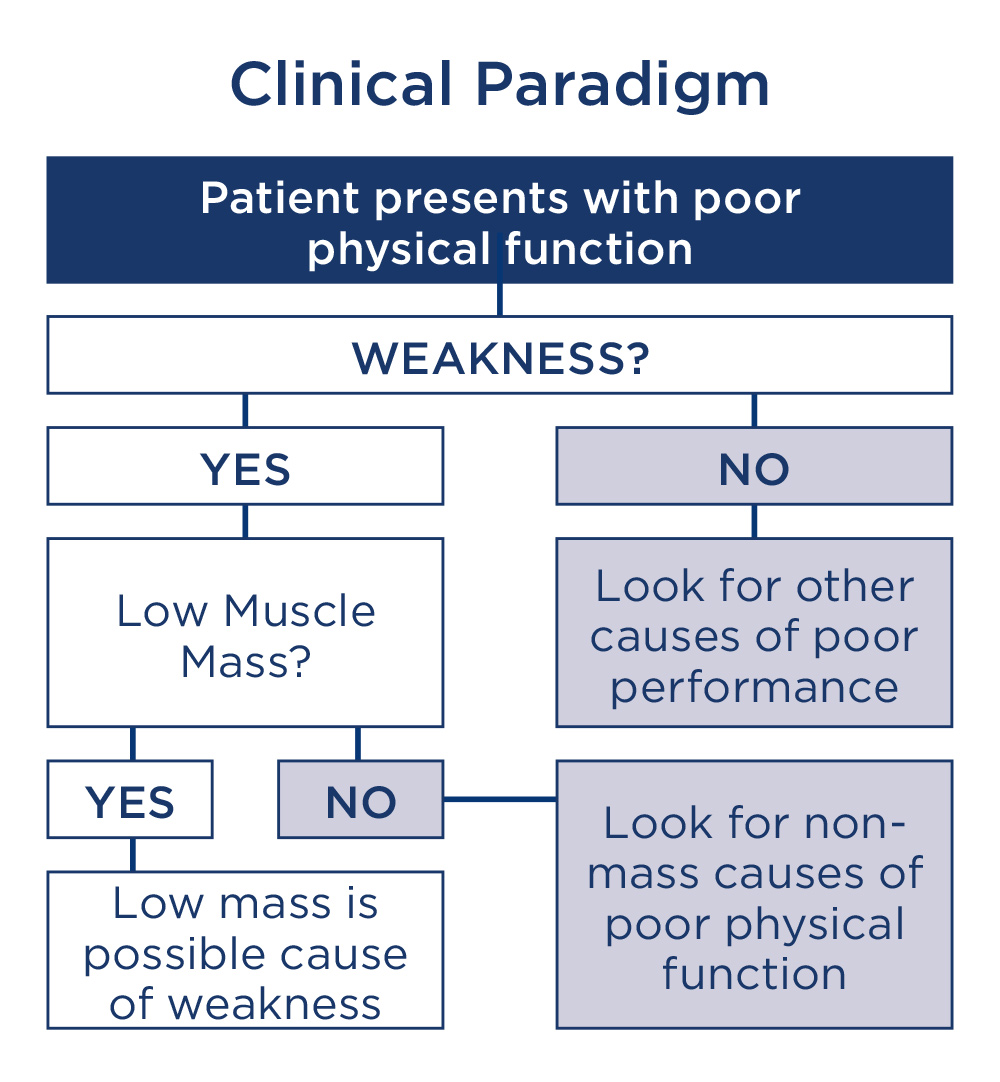Sarcopenia is defined as an age-related disease of low muscle mass and low muscle strength or function. It is of increasing clinical importance due to growing evidence of its health implications and the increasing proportion of older people in the population.
Sarcopenia has been associated with an increased risk and rate of falls, fractures, functional impairment, metabolic syndrome, hospital admission and readmission, poorer prognosis in cancer and liver cirrhosis, surgical morbidity and all-cause mortality. The clinical significance of sarcopenia as a distinct disease entity was established with the assignment of an International Classification of Diseases.

Figure 1 illustrates the steps involved in assessing for the presence of sarcopenia. In a presentation with poor physical function determine if weakness is present. If so, is there low muscle mass that is the cause? If so then this is the likely cause of weakness ie sarcopenia? If either weakness or low muscle mass is not present, assess for other possible causes.
Risk factors and clinical consequences
There is a complex interaction between muscle and bone. The main theory uniting sarcopenia and osteoporosis pathogenesis is the replacement of muscle and bone by adipose tissue with ageing. Poor muscle mass and function is associated with poor bone mass with the overlap between these two conditions called “osteosarcopenia”. Low muscle mass results in reduced muscle strength and function and high falls risk and consequent fracture risk due to poor bone mass (osteopenia or osteoporosis). The consequences are significant for morbidity, mortality, independent function and quality of life.
There are a few international definitions and cut offs for the definition of sarcopenia. A practical algorithm for the assessment of sarcopenia utilises gait speed (physical function), hand grip strength and muscle mass. Grip strength is measured using a hand dynamometer and muscle mass can be measured using DEXA (not HIC funded). Alternative and less readily available assessments include bioimpedence analysis, CT and MRI based muscle mass assessments.
 Management is problematic. There is little evidence but significant ongoing research in this area. The main components are non-pharmacological . This includes optimising such as nutrition especially adequate protein intake, regular and escalating exercise programs at least three times per week and escalating intensity (weight bearing and resistance), minimising falls risk and addressing underlying associated osteoporosis risk to reduce fracture risk.
Management is problematic. There is little evidence but significant ongoing research in this area. The main components are non-pharmacological . This includes optimising such as nutrition especially adequate protein intake, regular and escalating exercise programs at least three times per week and escalating intensity (weight bearing and resistance), minimising falls risk and addressing underlying associated osteoporosis risk to reduce fracture risk.
Potential pharmacological treatment thus far has not been promising. There is ongoing research into the roles of Vitamin D (anabolic), Monoclonal Myostatin antibodies, IGF1, Androgen Receptor – Testosterone and Selective Androgen Receptor Modulators (SARMS), and soluble ACTRRIIB-FC Fusion protein to block ACTRIIB to promote muscle hypertrophy (animal studies only). Time will tell.
Key messages
- Sarcopenia and osteoporosis are commonly associated with a frail, ageing population
- The consequences are significant including falls and fractures resulting in significant morbidity, mortality, loss of function and quality of life.
- Early identification and management strategies (prevention) is the most useful strategy until we discover effective pharmacological measures.
– References on request
Questions? Contact the editor.
Author competing interests: Nil.
Disclaimer: Please note, this website is not a substitute for independent professional advice. Nothing contained in this website is intended to be used as medical advice and it is not intended to be used to diagnose, treat, cure or prevent any disease, nor should it be used for therapeutic purposes or as a substitute for your own health professional’s advice. Opinions expressed at this website do not necessarily reflect those of Medical Forum magazine. Medical Forum makes no warranties about any of the content of this website, nor any representations or undertakings about any content of any other website referred to, or accessible, through this website.

